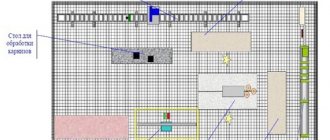- November 26, 2018
- Business plans
- Ksenia Stepanishcheva
Cheese is a popular product. The demand for it is constantly growing, and there are not many farms producing it. According to reviews, the cheese factory as a business is quite profitable. You just need to familiarize yourself with all the nuances and constantly monitor the process. We will look at its features in the article.
How to open a cheese factory? It is necessary to start a business with a clear definition of the development strategy. To do this, a business plan is drawn up with a detailed description of all the nuances. This will prevent unnecessary expenses in the future.
Advantages and disadvantages
Before opening any business, you should familiarize yourself with its pros and cons. In our case, the advantages are:
- Demand for the product among the population.
- Affordable cost of raw materials for production.
- A ban on the import of imported goods allows the promotion of cheeses from local producers.
But this business also has risks that you should prepare for. The disadvantages include:
- Short shelf life of some types of products.
- High competition.
- Unsatisfactory quality of raw materials leads to the manufacture of low-quality products.
- Lack of distribution channels.
Judging by the reviews, the business will be profitable if you approach this issue wisely. The owner will need to monitor the entire process of activity in order to produce high-quality products that will be in demand.
For convenience, the business plan is divided into points, after studying which you will have a clear idea of what is needed to open such an enterprise.
Is it profitable to open a cheese factory?
Opening a cheese factory today is profitable for a number of reasons:
- Cheese is a consistently popular product.
- Eco-products, the category of which will include cheese from your production, are in trend today.
- Thanks to sanctions, the import of cheeses from abroad has decreased, which means the niche has become freer.
- The state financially supports businesses related to agriculture and import substitution.
So, the prospects are bright. It remains to organize your business correctly, taking into account the specifics of cheese production.
Registration
First you need to register the cheese factory as a business. Reviews indicate that this is not difficult to do. If the company is small, you can register as an individual entrepreneur. But many choose the LLC organizational form, since they are more willing to work with legal entities and have more trust in them. A simplified taxation system is chosen, when you need to pay 6% of revenue or 15% of net income.
In both cases, a license is required. After registering an individual entrepreneur, a certificate is provided. This procedure is carried out by the branch of the Federal Tax Service of Russia at the place of residence. To register you need to submit:
- Russian Federation passports;
- statements;
- applications for a simplified taxation system;
- receipts for payment of state duty;
- TIN certificates.
When these papers are submitted, a receipt is provided. The registration period is no more than 3 working days. It is important that the products are certified, and for this they collect documents: an application, constituent papers, a quality certificate.
Market analysis
It is important to familiarize yourself with the market and customer needs. You should analyze the activities of competitors, their range, average prices. It is necessary to determine the solvency of the population of the sales region. This will allow us to formulate a pricing policy and assortment.
According to reviews, a cheese factory as a business is in demand only when the most popular product is selected. And here it is sometimes very difficult to make a choice. Hard cheese is popular. However, it is worth considering that the technology for its creation requires a lot of time. Compared to cream and tea cheeses, the production of hard varieties requires long aging. In addition, premium products need to mature for at least a year. Such cheese factories are usually opened with appropriate experience.
It is important to select the assortment as this influences the choice of equipment. Cheeses are:
- rennet;
- hard;
- soft;
- pickled;
- fermented milk;
- whey;
- smoked;
- with Penicillium mold.
Not a drop by: how to earn the maximum
Saving raw materials is an important point in cheese production. Both your own and store-bought milk should be used to the last drop. The same applies to whey, which is obtained after separating the cheese grain from milk. Prepare cottage cheese, yogurt, fermented baked milk based on it - you will diversify the assortment and increase your customer base.
How else to attract buyers? It is best to establish contacts with large buyers of raw materials at a business meeting, but you can notify retail consumers about the opportunity to buy organic cheese nearby in various ways. Distribute leaflets to organic food stores, start a group on social networks, create an online store (you can start with bulletin boards and free platforms), run a short advertisement on local TV - why not? Treat your audience wisely: offer a product that people can afford. For some, relatively inexpensive soft cheeses and fermented milk, for others, premium products, cheeses aged for many months. Form an assortment in accordance with the main category of buyers, not forgetting that it is impossible to produce all varieties at once. This way you will achieve complete sales of products, which means that the business is successful.
Room
A business plan for a cheese factory must be drawn up, including all the nuances. Information about the premises is also indicated there. If a mini-workshop is opened to create cheese with a capacity of 100 kg per day, then you need a room of 20 m². For rent you should find about 30-50 thousand rubles. But usually farms allocate areas on their territory. The equipment is compact, usually 70 cm in diameter and 90 cm in height.
According to reviews, a cheese business must meet all requirements. Therefore, it is important to have cold and hot water supply, sewerage, ventilation, and heating. The cheese factory must meet the requirements for the premises where food products are produced. This applies to:
- natural light;
- metal or plastic furniture;
- tiled walls;
- fire safety equipment.
If all requirements are met, no problems will arise during the inspection by regulatory authorities. In addition, such a premises will allow the production of high-quality products.
Equipment
It is allowed to open a home automatic cheese factory. Then, when manufacturing products, the equipment automates the process of milk coagulation, formation of cheese grains, mass molding, pressing and salting. The goods are stored and matured in refrigerated chambers.
You should first select the technology for making cheese, since any changes in it will require adjustments to production and may require new equipment. It can be main or auxiliary. The first includes a 50 liter stainless steel container. Auxiliary consists of:
- shelving;
- milk filters;
- coolers;
- maturation chambers;
- press tables;
- cheese molds;
- brine pools.
There are ready-made cheese production lines that differ in productivity. For example, for a mini-workshop of a small farm, a 120-liter line is installed. It is capable of processing 500 liters of milk per day.
The business plan for a cheese factory must include the necessary equipment. You should choose it carefully and not save, as this affects the quality, as well as the demand for the product. According to reviews, many cheese factories have Italian equipment. It has an optimal price-quality ratio and is also considered universal. Such a line costs about 3 million 750 thousand rubles. It is important that the equipment supplier provides maintenance.
The Russian line has a lower price - from 150 thousand rubles with a productivity of 70-1000 liters of milk per day. The minimum production required is:
- sour cream – 5 kg (fat content 20%);
- soft cheese – 13 kg;
- hard cheese – 7 kg;
- drinking products – 100 l.
Cheese factory business plan
Writing a business plan is a mandatory preparatory stage, which will allow you to determine the volume of investment, payback period, and cost of cheese. The business plan includes risk assessment, competitor analysis, etc. If you want to get a bank loan or a subsidy from the state, a business plan is simply irreplaceable.
Registering a business: necessary documents and permits
If you are going to run a business legally, you will have to undergo mandatory certification. This is a rather complicated and expensive procedure, but without a quality certificate you won’t be able to get it on store shelves. If you plan to sell cheese through friends, rely on word of mouth and advertisements on the Internet, then you can do without certification.
The production and sale of cheese is regulated by the technical regulations of the Customs Union 033/2013 “On the safety of milk and dairy products.” Certification is carried out using a declaration form. Certification centers will help you draw up a declaration. The cost of their services differs by region. Obtaining a declaration will cost 7 thousand rubles. (for a year) or 15 thousand rubles. (for 3 years). The maximum period for which a declaration is issued is 5 years.
Declaration can be carried out according to one of five schemes. Receiving a declaration involves the following steps:
- Collection and analysis of evidence.
- Production control. This stage is provided only by schemes 1, 4 and 6 days.
- Testing of specially selected samples of cheese and cheese products.
- Acceptance of the declaration by the applicant - if satisfactory results were obtained during the previous stages.
- Registration of the declaration in the Unified Register.
- Applying a single sign of circulation in the Customs Union to the packaging of cheese and cheese products.
Evidence materials include:
- cheese research protocols;
- documents on state registration of the enterprise as an individual entrepreneur or legal entity;
- previously issued certificates - if they were issued, but under scheme 6d their presence is mandatory;
- description of raw materials, production equipment, processes associated with the release of cheeses into circulation;
- regulatory documents - technical regulations, GOSTs, etc.;
- shipping documents or supply contracts - provided when choosing schemes 2 and 4 d;
- other documents that can confirm the compliance of cheeses with the requirements of technical regulations.
Certification according to the declaration form requires the preparation of a large number of documents, but it clearly indicates the high quality of the products.
Permission from Rospotrebnadzor
To sell cheese, you must have permission from Rospotrebnadzor. To obtain permission you must provide:
- state registration certificate;
- taxpayer certificate;
- equipment list;
- technological production maps;
- premises rental agreement;
- confirmation that employees have undergone a medical examination;
- ventilation documents;
- waste removal agreement.
What regulations regulate cheese production?
The production of cheese is regulated by sanitary rules and regulations SANPIN 2.3.4.551–96 “Production of milk and dairy products.” This is a voluminous document that defines the conditions for cheese production: what the premises and equipment should be like, how to organize laboratory control, describes occupational hygiene, requirements for deratization, disinfection, etc.
It would be useful to study GOSTs, for example, general technical conditions for cheeses are prescribed in GOST R 52686–2006, for semi-hard cheeses - in GOST R 52972–2008.
Cheese production is regulated by GOSTs and SANPINs
Equipment
There are many manufacturers of cheese factories designed for different volumes of milk processing. At the same time, there are many inexpensive mini-factories. For example, there is a company called Sfoggia (Italy), which produces cheesemakers with a capacity of 120 and 360 liters. In two 8-hour shifts, such a cheese factory (with a capacity of 360 liters) can turn up to 1,400 liters of milk into cheese. This will produce about 210 kg of cheese.
Mini cheese factories are quite affordable
Among the Russian manufacturers, one can highlight Barnaul, which produces Cheese-Master 150. Their cost is from 150 thousand rubles. (with a capacity of 700–1000 liters per day). This allows you to get 7–9 kg of hard cheese or 13–15 kg of soft cheese.
Equipment for a cheese factory includes a stainless steel container, which is heated in various ways.
The container for cheese production must have a volume of at least 50 liters
It is necessary to purchase racks, press tables, salting basins, and cheese molds. If you produce hard cheeses, you will need ripening chambers. Some of the equipment can be made independently: for example, a press table will replace heavy plywood.
Selection of raw materials
Cheese production technology involves the use of cow, goat, sheep and other types of milk. It can be obtained in several ways:
- acquisition from private farms;
- purchase from farms;
- maintaining your herd.
The first option is considered risky, since it is difficult to control the quality of milk. But this is the cheapest method. Rural residents take advantage of the opportunity to earn money from milk, especially if the buyer himself organizes its transportation.
A reliable method is to purchase from farms, which sell their surplus to factories at a low price. But the best option is to have your own herd. In this case, milk is obtained at cost, and it will be possible to independently control its quality.
The technology for making cheese is characterized by the absence of production waste. Everything is used for sale. It is possible to sell not only hard, soft, and rennet varieties of cheese, but also the whey left after their preparation.
Step-by-step instructions for opening a cheese production
To conduct production of cheese products, a sequence of actions must be clearly developed. We should not forget about the requirements for the premises, the purchase of raw materials and equipment, and the recruitment of personnel for work. For a better understanding, we will consider each point separately.
Step 1. Room
The owner of a cheese production must take into account all technical standards and regulatory requirements that apply to the premises.
Otherwise, he faces administrative penalties. Premises requirements:
- high-quality lighting, heating and water supply;
- the presence of a working sewer system;
- indoor renovation and wall finishing with antibacterial tiles;
- working ventilation system and fire safety equipment.
Step 2. Purchase of raw materials
An important stage is the purchase and preparation of raw materials for production.
The main ingredient for cheese is milk. The technological process makes it possible to use cow, goat and sheep milk. You can get it in the following ways:
- purchase of raw materials from private individuals;
- on farms;
- maintaining your own herd.
The first method is not suitable due to the unreliability of product quality. It is best to purchase raw materials from farms. To avoid purchasing low-quality raw materials from distributors, it is necessary to require documentary evidence of certification of the products sold.
The best option is to raise your own herd. Then the entrepreneur will be confident in the quality of the main raw materials.
This also applies to the processing and cultivation of special additives, for example, spices to create new varieties of cheese products.
You can transport milk using your own transport. This is beneficial because the employee will be responsible for compliance with the rules for the transportation and delivery of raw materials to the storage location. Milk for further processing should be stored in clean, closed containers in refrigeration equipment.
Conditions for purchasing milk:
- A veterinary certificate must confirm the quality of the milk.
- The temperature of purchased milk should not exceed 12 standard units.
- Fat content of the product is up to 3%.
- Does not contain antibiotics.
Step 3. Equipment
Without special equipment and additional devices, the technology will not be maintained at any stage of cheese production. You will need:
- Molding equipment.
- Closed tanks for storing raw materials.
- Filters for milk processing.
- Baths or pools for long-term pasteurization.
- Cheese ripening chambers.
- Milk coolers.
- Racks for sorting and ripening of finished products.
- Paraffiners for long-term storage of cheese.
- Containers for moving products.
- Press tables.
For mini-workshops, you can purchase a ready-made line with the required productivity coefficient. To process 600 liters of milk, an automatic line of 120 meters is sufficient.
The quality of the product depends on the operation of the equipment, so it is better to purchase your own than to rent for a while.
Italian production lines are most suitable for producing cheese at home. The optimal price-quality ratio, as well as the use of high technology, will help make the products excellent in taste.
It is best to purchase equipment from direct suppliers, agreeing on its further maintenance.
The cost of domestic equipment starts from 180,000 rubles, but it is not very productive. Although, in a small production environment, it is quite possible to produce soft, hard cheese and sour cream in minimal quantities.
Step 4. Employees
To service the line in a small production facility, up to 3 personnel will be needed.
Also, your business cannot do without the help of a cheese-making technologist. His knowledge will help develop new types of cheeses and will be required in many technological aspects of cheese production. You also cannot do without a sales and supply manager. If it is not possible to employ such a unit, then the owner will have to take over its functions.
Personnel must be officially registered for work in accordance with the laws of the country.
Documents for applying for a job:
- Passport and its copy.
- Employment history.
- Diploma of education in the food industry or certificate of completion of similar courses.
- Military ID.
- Sanitary book.
Very important : it is not allowed to require documents prohibited by the legislation of the Russian Federation from citizens applying for work.
Production technology
Cheese making at home or within a workshop is carried out using typical technology for the production of hard and soft varieties. It is as follows:
- preparing milk for coagulation with special substances and heat;
- formation and ripening of cheese;
- packaging and sales.
Production technology assumes that the mini-workshop is divided into production zones. There should also be a warehouse and a shipping room.
Creation of Suluguni
For example, we should consider a simplified technology for creating Suluguni cheese. This is a popular brine Georgian variety. Classic suluguni is made from cow or buffalo milk. A combination of 2 types of raw materials in different proportions is allowed.
To create suluguni, you need to add enzymes for ripening and rennet enzymes for cheese to the milk. It is important that the dishes are not enameled, otherwise the product will not work. Then the mixture is boiled at 30-35 degrees for 30 minutes. It must be stirred every 10 minutes until a clot forms. Suluguni is prepared with one boil.
During cooking, the curd is turned over so that it is cooked on all sides. After this process is completed, the whey is pumped out, and the suluguni is pressed so that part of the whey remains in it. The cheese ripens under pressure for 2-5 hours, during which time regular turning is required. After which the product is cut into pieces and moved to salting. This procedure is carried out in brine baths. The time depends on the size of the pieces.
Soft cheeses
According to reviews, a cheese factory as a business is in demand for the production of various types of products. Soft varieties that are easier to prepare than others are in demand. In this case, the milk is curdled, the cheese is strained and pressed into portions for sale. The main advantage of soft varieties is their rapid production.
Such cheeses are made without ripening in a few days, within a week, or using long-term ripening technology (up to 45 days). Implementation must be completed within 2 weeks. The best taste appears in 1 week.
Elite varieties
Typically, the production of elite cheese varieties requires a long ripening period for the product. For example, to create Brie cheese, fermentation is aged for 18 hours. And when mold is added, the period is about 2 months.
Among the elite varieties, Mozzarella is distinguished, but it is prepared quickly and without additives. It will take no more than 2 days. The products retain their beneficial properties and are rich in calcium. Goat cheese, Feta, and semi-hard types are also elite. The latter are created using solid version technology. But the formation occurs independently, without a mechanical press.
Sales
Whatever types of cheese are produced, it is necessary to determine distribution channels. Implementation will be much easier if there is a large city nearby. Then the products can be sold in several ways:
- sale to catering establishments;
- supply to retail chains;
- wholesale sales to stores;
- sales to wholesale resellers;
- trade from a mobile store on the road;
- sales in markets;
- sale through a company store.
Through your store you can sell not only suluguni, hard, rennet, soft varieties, but also excess milk and whey. This increases production profitability. It is advisable to arrange supplies of eco-products to different stores. Elite varieties are sold to restaurants and cafes.
But cheese production does not give quick results. One line requires considerable funds, which do not pay off in 1 year. But the production cycle of some varieties takes more than one month.
Risks and guarantees
The main risks of the project can include:
- Creating a cheese recipe: a long preparation stage is required before production begins, selecting the most successful options and ingredients.
- The influence of seasonal factors on product quality. The quality of cheese directly depends on milk, the biochemical composition of which is constantly changing as animals eat different herbs in different seasons. To do this, you need to carefully select suppliers who closely monitor the diet of their animals.
- Failure to fulfill sales plans. Active work is required to search for new sales channels, establish feedback with the end consumer, clarify his preferences and wishes, and competent interaction between sales consultants and clients.
The advantages of the project include a favorable location, which allows you to count on a constant flow of customers, the absence of competitors in the market, which allows you to set high markups, as well as the liquidity of tangible assets, which can guarantee a quick return on your investment.
Calculations and profitability
Costs required:
- for the production line with delivery and installation – 300 thousand rubles;
- renovation of the premises - 200 thousand rubles;
- employee training – 30 thousand rubles;
- registration and other expenses - 100,000 rubles.
These are approximate expenses, depending on the type of enterprise they may differ. In total, about 630 thousand rubles are needed. In addition to these funds, every month there will be expenses:
- for advertising – 20 thousand rubles;
- utility costs - 30,000 rubles;
- salary for 4 people – 80,000 rubles;
- rent - 30,000 rubles;
- other expenses – 50 thousand rubles.
It turns out that you will have to spend about 210 thousand rubles per month with 22 days of work and a productivity of 100 kg of product per day. This way it will be possible to create 2200 kg of hard and soft cheeses.
The average selling price is 200 rubles per 1 kg. If you subtract expenses on raw materials, then the monthly revenue will be equal to 286 thousand rubles. Expenses and taxes are subtracted from the amount, and the profit will be about 64 thousand rubles per month. This means that when selling products, the business will be able to fully pay for itself in 10 months. The profitability of the cheese factory is 20%.
How much does it cost to open a cheese factory?
Initial Investment
Opening a cheese factory is not a cheap pleasure; this enterprise will require significant capital investments. The list of equipment, transport and other initial expenses planned for purchase was presented earlier; let’s summarize this data in our table.
| Total | |
| Name | 1 year |
| Purchasing premises | 650000 |
| Room renovation | 200000 |
| Purchase of equipment | 737400 |
| Installation of equipment with materials | 150000 |
| cooling chamber | 200000 |
| Delivery and installation of the camera | 5000 |
| Training | 30000 |
| Buying a gazelle | 700000 |
| Organizational expenses | 16000 |
| Total | 2688400 |
Thus, the initial costs will be at least 2,700,000 rubles.
Organizational opening plan
The organizational plan for opening production will look like this.
| January | February | March |
| Collection of documents for | ||
| sales transactions | X | |
| Execution of the transaction | X | |
| Room renovation | X | |
| Selection and installation of equipment | X | X |
| Recruitment and training | X | X |
| Launch of production | X | |
| Reaching planned turnover | X |
Planned revenue
For calculation purposes, it is assumed that one kilogram of cheese is produced from 6 liters of milk. Thus, the production of 1500 kg of cheese per month is taken as 100% of the trade turnover of Cheese LLC. The cost of production is based on an express analysis of the average price of cheese in private cheese factories.
The duration of the period to reach the planned capacity from the start of the project is three months.
A uniform distribution of demand over time is assumed.
There will be whey left over from cheese production, which will be sold to farmers on farms to feed calves. To calculate the business plan, it is assumed that the cost of selling cheese is 350 rubles per kilogram, the cost of selling whey will be 10 rubles per liter.
| Total | Total | Total | |
| 1 year | 2 years | 3 years | |
| Revenue from cheese sales | 4410000 | 6300000 | 6300000 |
| Proceeds from the sale of whey | 450000 | 540000 | 540000 |
| TOTAL | 4860000 | 6840000 | 6840000 |
Costing
Cost calculations are based on forecast conditions
Fixed and variable costs are distinguished.
Costs are taken on the condition that 100% of the planned sales volume is achieved.
Payroll costs are discussed above. Utility costs for calculation are assumed to be 15,000 rubles per month. Electricity costs for the purchased equipment are 2400 kW/hour. Water consumption – 13.88 m3, sewage waste – 9.92 m3.
The cost of packaging and gasoline for the Gazelle will be 5% of the cost of purchased milk.
Other fixed expenses are accepted in the amount of 5,000 rubles per month, which includes services such as bank services, stationery, and property tax.
Other variable expenses are assumed to be 10,000 rubles per month. These costs include payment for various services associated with cheese production.
| Total | Total | Total | |
| 1 year | 2 year | 3 years | |
| Fixed expenses | |||
| Wage | 745500 | 804000 | 804000 |
| Payroll taxes | 152082 | 164016 | 164016 |
| Accountant services | 88000 | 96000 | 96000 |
| Other fixed expenses | 55000 | 60000 | 60000 |
| Variable expenses | |||
| Milk cost | 2070000 | 2700000 | 2700000 |
| Cost of sourdough, enzyme | 50000 | 60000 | 60000 |
| Package | 103500 | 135000 | 135000 |
| Transport | 103500 | 135000 | 135000 |
| Equipment depreciation | 2672400 | 0 | 0 |
| Communal expenses | 165000 | 180000 | 180000 |
| 110000 | 120000 | 120000 | |
| Other variable expenses | 110000 | 120000 | 120000 |
| TOTAL | 6424982 | 4574016 | 4574016 |











